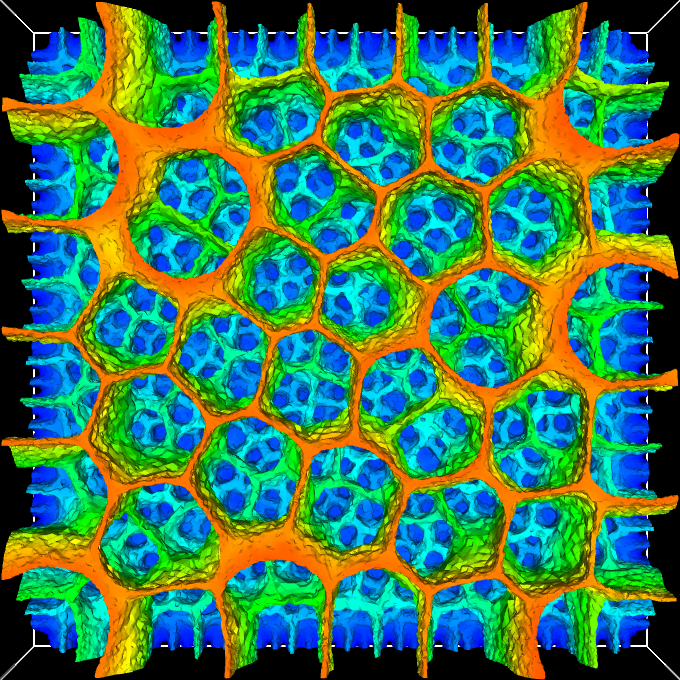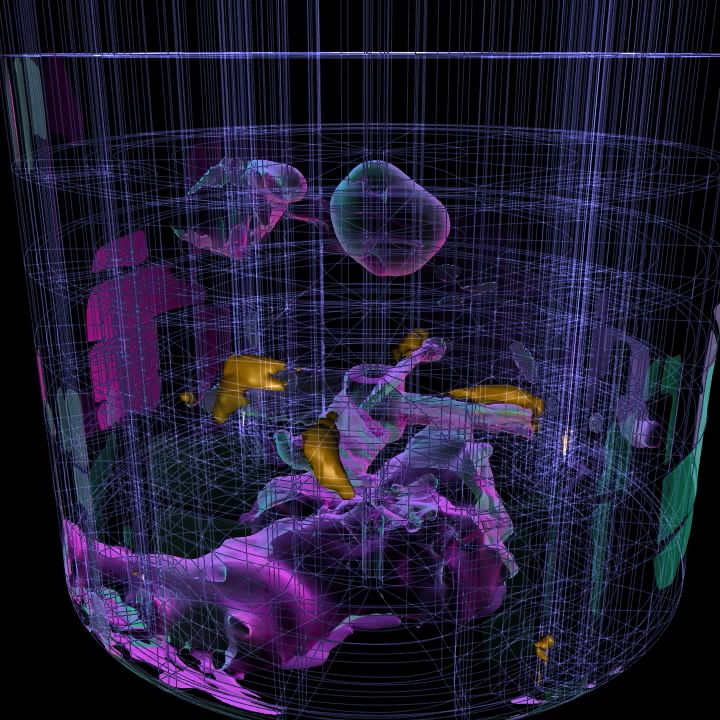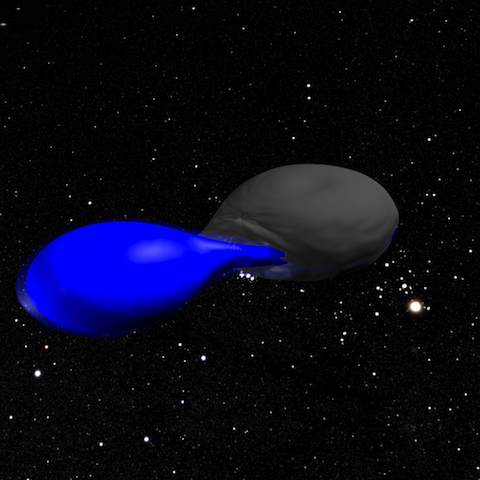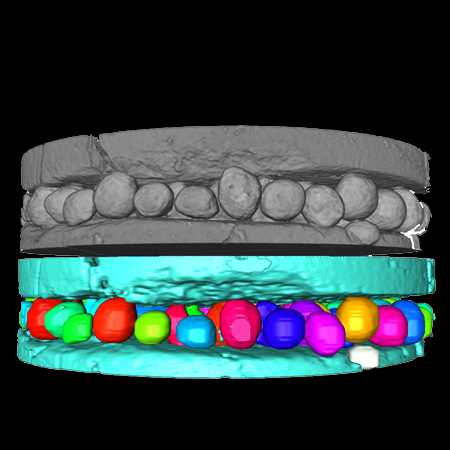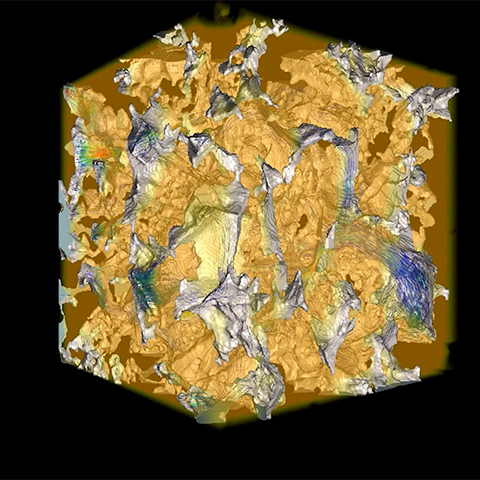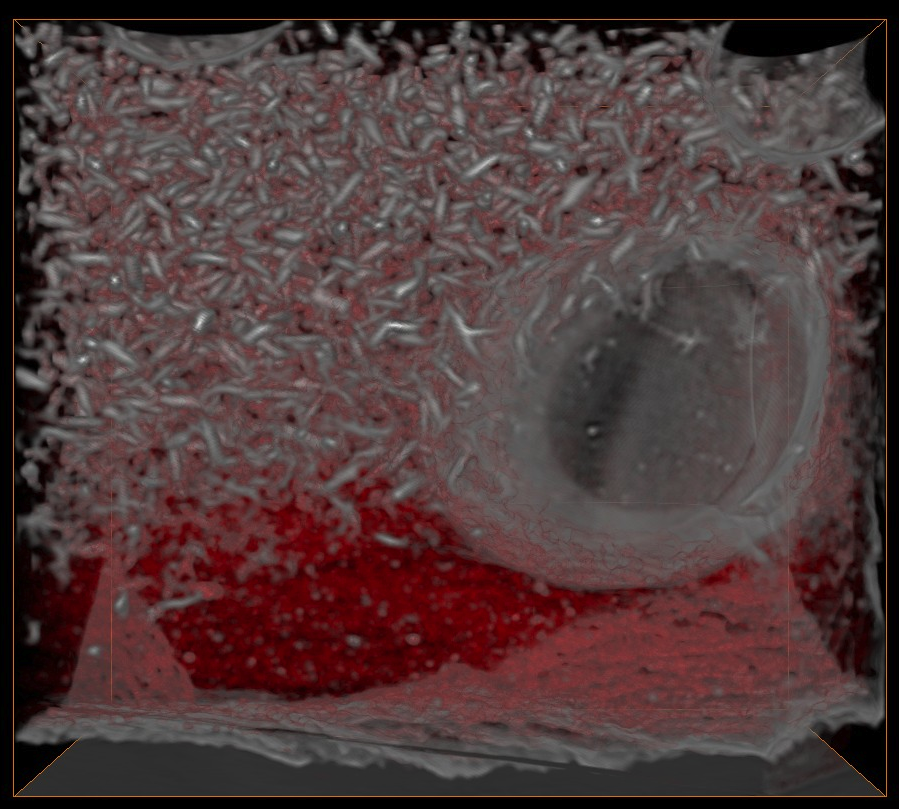Visualization Movies¶
A Variational Approach to Brittle Fracture : Research led by Dr. Blaise Bourdon, Department of Mathematics, LSU.
When a hot object is put on top of a cold surface, the transmission of temperature causes fracture inside the hot object to occur. The fracture starts with many small features and grows into fewer larger grids, finally take a shape of a factal pattern. The simulated data is about 64 GB in size and include 200 timesteps. The data is originally unstructured tetrahedral grid and resampled into regular grid before creating visualization plots. The fracture pattern is rendered as isosurface colored by temperature. The visualization emphasize the growth of the frature pattern and the transmission of temperature while the fractures form.
Download:
dryingbrick 4k (914MB)
dryingbrick 1080p
thermalcrack 4k (455MB)
thermalcrack 1080p
Deep water horizon oil spill : Research led by Dr. Louis Joseph Thibodeaux, Department of Chemical Engineering, LSU
During the BP deep water horizon oil spill, lots of oil residue is found suspended in water. The theory is that oil shoots out and begin to spread at a certain water depth when water density reaches a threshold level. While large amount of oil stays at that water depth, some oil keep fleeing to the surface. In this visualization we simulate this phenomenon use Maya particle dynamics and underwater environment rendering.
Download:
4k (400MB)
1080p (245MB)
Turbulent flow in a stirred tank reactor : Research led by Dr. Sumanta Acharya , Department of Mechanical Engineering, LSU
The turbulent flow in a cylindrical stir tank stirred by rotating impellers is simulated using computational fluid dynamics. This visualization features Velocity micro-streamlines and pressure isosurfaces over the impeller blade, to show the circulating motion of fluid within the tank. The simulation data is about 500 GB in size and include more than 5000 time steps. The movie image sequence is rendered by Dr. Werner Benger using his visualization software Vish.
Download:
4k (10.3GB)
1080p (2GB)
Protostellar Jet from a One Solar Mass Star : Research led by Dr. Jan Staff, Dr. Joel Tohline, Department of Physics and Astronomy, LSU
The protostellar phase is an early stage in the process of star formation. For a one solar-mass star it lasts about 100,000 years. It starts with a core of increased density in a molecular cloud and ends with the formation of a T Tauri star, which then develops into a main sequence star. The dataset produced from the jet simulation has about 1300 time steps, total about 20TB data in storage. The movie image sequence is produced at LSU HPC resources, using parallel visualization software VisIt, developed by Lawrence Livermore National Lab (LLNL). The density of the expanding jet cloud is visualized by volume rendering with transparency, and the rovolving magnetic field is depicted by animated streamlines computed from the vector field.
Download:
4k (819MB)
4k H.264
1080p (319MB)
720p
480p
Merger of two White Dwarfs : Research led by Dr. Joel Tohline, Department of Physics and Astronomy, LSU
One carbon-based and another gas-based white dwarfs orbit each other. The stars spiral closer and closer together, and finally collide and merge. The dwarfs’ density are extracted as iso-surfaces from simulated datasets in a cylindrical coordinate system. The total simulation produces about 4000 time steps that progress forward in time hundres of years. The rotation speed is about 18 degrees per frame. A star field is rendered as background to enhance the spacial illusion. The rendering and lighting are produced in Maya software, and rendered at LSU HPC resources.
Download:
4k (1.68GB)
1080p (536MB)
MicroScale Shale Segmentation : Research led by Dr. Clint Willson, Department of Civil and Environmental Engineering, LSU
Micorscale proppants are injected into a shale (roughly 2mm in diameter ) to open up for flow passage. The shale and proppant dataset is imaged at LSU Center for Advanced Microstructures and Devices (CAMD) with 2.5 micron resolution. The visualization shows the segmentation of shale and proppants, and exposes the open passage for flow. The passage space will later be rebuilt and saved as triangular or tetrahedral grid for FEM flow simulation.
Download:
4k (369MB)
1080p (138MB)
Singing Cardinal: Research led by Dr. Dominique Homberger, Department of Biology, LSU, Dr. Rodrick Suthers, Indiana University
To study the vocalization of songbird, here the Northern Cardinal, a collaboration is established between Dr. Dominique Homberger’s lab at LSU Department of Biology and Dr. Rodrick Suthers’s Lab from Indiana University. The cardinal is imaged from xray CT scan at LSU Vet school. The bone structure, especially anatomically correct vocal apparatus, are segmented into separate pieces and exported as a 3D surface model. The 3D model is then imported into Maya software to create the Cardinal character rig – a chain of kinematic joints and bones set up to animate a 3D model. At Indiana university, X-ray videos are produced in 980 by 980 resolution while a live Cardinal singing songs. To reproduce the exact same vocal movement using the 3D model, the Cardinal character is pose-matched frame by frame to the image sequence of the singing x-ray video. The animated Cardinal model can be used to study and teach the vocalization mechanism of a songbird.
Download:
4k (479MB)
1080p (76MB)
Simulated Flow Through Porous Media : Research led by Dr. Karsten Thompson, Department of Petroleum Engineering, LSU
Image-based pore-scale modeling is a powerful computational tool for investigating transport in porous geologic materials. The following is a Finite Element (FEM) Stokes Flow simulation of a Newtonian fluid (such as water) through a common porous geological material - Berea Sandstone. The sandstone sample is imaged (via Synchrotron XCT) at 2.5 micron resolution at LSU Center for Advanced Microstructures and Devices (CAMD). The 3D image is then segmented into sand grain and pore spaces and saved as unstructured triangular and tetrahedral grid for FEM flow simulation. The computed flow data is loaded into Avizo visualization software as a vector field on top of the original volume space. From the vector field animated streamlines are produced to depict the direction and velocity of the flow paths through the pore space. Animated particles are also created and moved forward along a selected streamline, to highlight the effect of an active flow.
Download:
1080p (327MB)
4k (5.1GB)
Flame Retardant Blend Sample Burning Test : Research led by Dr. Leslie Butler, Department of Chemistry, LSU, Dr. Kyungmin Ham, CAMD, LSU
The samples are small piece of plastic mixed with flame retardant polymer. The sample are burned to see if it catches fire, if not, then the blend passes the test. Here we have four samples each with a different blend, after the burning test the samples are scanned to 3D volumes by CAMD beamline scientist. The 3D volumes are studied in order to find out characterics that may cause a specific blend to pass or fail the test. In this movie we use Avizo software to visualize the samples, showing features revealed by the 3D datasets, such as burn surface, char layer, crack, bubble, and polymer distribution.
Download:
1080p (250MB)
4k (723MB)
A Tour of Moon : Research and Rendering by Dr. Robert Kooima, Department of Computer Science, and CCT, LSU
Download:
4k clip-1 (984MB)
4k clip-2 (835MB)
4k clip-3 (2.26GB)
